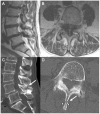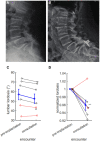Neurosurgical Management of Interspinous Device Complications: A Case Series
- PMID: 35372480
- PMCID: PMC8965756
- DOI: 10.3389/fsurg.2022.841134
Neurosurgical Management of Interspinous Device Complications: A Case Series
Abstract
Background: Best practice guidelines for treating lumbar stenosis include a multidisciplinary approach, ranging from conservative management with physical therapy, medication, and epidural steroid injections to surgical decompression with or without instrumentation. Marketed as an outpatient alternative to a traditional lumbar decompression, interspinous process devices (IPDs) have gained popularity as a minimally invasive stabilization procedure. IPDs have been embraced by non-surgical providers, including physiatrists and anesthesia interventional pain specialists. In the interest of patient safety, it is imperative to formally profile its safety and identify its role in the treatment paradigm for lumbar stenosis.
Case description: We carried out a retrospective review at our institution of neurosurgical consultations for patients with hardware complications following the interspinous device placement procedure. Eight cases within a 3-year period were identified, and patient characteristics and management are illustrated. The series describes the migration of hardware, spinous process fracture, and worsening post-procedural back pain.
Conclusions: IPD placement carries procedural risk and requires a careful pre-operative evaluation of patient imaging and surgical candidacy. We recommend neurosurgical consultation and supervision for higher-risk IPD cases.
Keywords: complications; decompressive laminectomy; interspinous device; lumbar stenosis; minimally invasive (MIS).
Copyright © 2022 Florence, Say, Patel, Unterberger, Laiwalla, Vivas and Lu.
Conflict of interest statement
The authors declare that the research was conducted in the absence of any commercial or financial relationships that could be construed as a potential conflict of interest.
Figures





References
-
- Chiu JC. Interspinous process decompression (IPD) system (X-STOP) for the treatment of lumbar spinal stenosis. Surg Technol Int. (2006) 15:265–75. - PubMed
LinkOut - more resources
Full Text Sources

